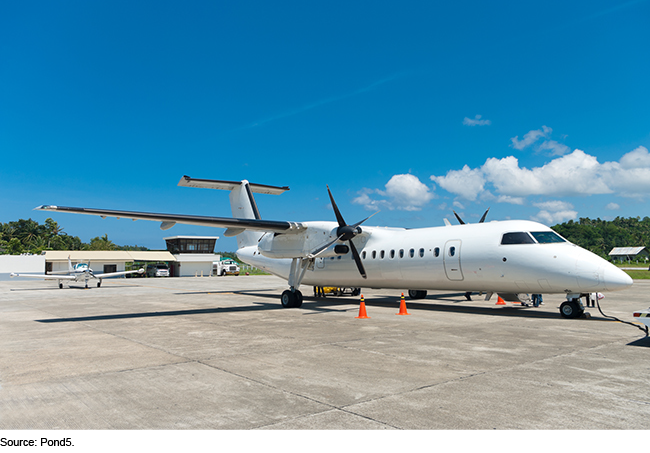Financial Assistance: Lessons Learned from CARES Act Loan Program for Aviation and Other Eligible Businesses
Fast Facts
The CARES Act authorized Treasury to provide up to $46 billion in loans to airlines and other aviation businesses affected by the COVID-19 pandemic. The loan program had 267 applications and provided 35 loans worth $21.9 billion.
Treasury prioritized applications from the largest passenger airlines—awarding 7 loans for about $20.8 billion. Most applications were from smaller carriers, ticket agents, and other businesses. These took longer to process and resulted in relatively few loans.
We suggest communicating clearer goals and timelines for future programs.

Highlights
What GAO Found
The CARES Act authorized up to $46 billion for the Department of the Treasury (Treasury) to make loans to aviation and other eligible businesses affected by the COVID-19 pandemic. Of the 267 applications submitted to the loan program, 35 loans providing $21.9 billion in assistance were executed. Treasury officials do not expect to make any additional loans before Treasury's authority to make loans expires.
Applications and Loans for CARES Act Loan Program for Aviation and Other Eligible Businesses, by Category in Statute
|
Type of business |
Number of applications submitted |
Assistance sought/available (billions of dollars) |
Number of loans executed |
Assistance provided (billions of dollars) |
|
Passenger air carrier, repair station operator, and ticket agent |
183 |
35 / 25 |
23 |
21.2 |
|
Cargo air carrier |
10 |
0.8 / 4 |
1 |
0.002 |
|
National security business |
74 |
2.6 / 17 |
11 |
0.7 |
|
Total |
267 |
38.3 / 46 |
35 |
21.9 |
Source: GAO analysis of Department of the Treasury data | GAO-21-198
Note: Pub. L. No. 116-136, § 4003(b)(1)-(3).
Participation in the loan program varied across business types due to timing of decisions and other factors, according to stakeholders. Treasury prioritized applications from the largest passenger air carriers and executed loans with seven of them for nearly $20.8 billion. For other applicants, including smaller passenger air carriers and ticket agents, the amount of time Treasury took to evaluate their applications and other challenges affected the number of loans executed, according to selected industry associations.
Treasury's authority to make new loans under this program is set to expire in December 2020, and the loan program offers Congress and Treasury lessons for designing and implementing programs of this type in the future. For example:
- Multiple programs, or multiple paths within a program, may better accommodate businesses of varied types and sizes. It is difficult to implement a program quickly for a wide range of businesses. In addition, a loan program well suited to large, financially sophisticated applicants will not likely be well suited to smaller businesses.
- Setting and communicating clear program goals could better align lender and borrower expectations. Treasury viewed itself as a lender of last resort but did not state this view in published documents. This omission led to some applicants being surprised by parts of the process, such as when Treasury encouraged over a third of all applicants to apply to another loan program before continuing to pursue a loan from Treasury.
- Communicating clear timelines for action can also help align lender and borrower expectations. The lack of a published timeline resulted in frustration among some applicants when loans were not made more quickly.
Why GAO Did This Study
The COVID-19 pandemic has resulted in catastrophic loss of life and substantial damage to the global economy, including the aviation sector. U.S. passenger air carriers have lost almost $20 billion and over 47,000 jobs in 2020, with losses forecast to continue into 2021.
In March 2020, Congress passed, and the President signed into law, the CARES Act, which provides over $2 trillion in emergency assistance and health care response for individuals, families, and businesses affected by the COVID-19 pandemic, including businesses in the aviation sector.
The CARES Act contained a provision for GAO to review the loans provided under the Act. This report examines, among other things, eligible businesses' participation in the loan program and lessons learned from the program for Congress and Treasury.
GAO reviewed Treasury documents and data on applications received and loans executed; interviewed Treasury officials on the design and implementation of the program; and interviewed eight industry associations that represent the range of businesses eligible for loans, eight passenger air carriers, and other selected applicants to gather their views on the program.
GAO will continue to monitor and report on CARES Act assistance to the aviation industry. This oversight includes the loan program and another Treasury program—the Payroll Support Program—that provided assistance to certain aviation businesses to continue paying employee wages, salaries, and benefits.
For more information, contact Heather Krause at (202) 512-2834 or krauseh@gao.gov.
